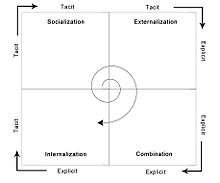SECI model of knowledge dimensions

SECI model of knowledge dimensions
Four modes of knowledge conversion were identified (Figure 1):
- Tacit to Tacit (Socialization) - This dimension explains Social interaction as tacit to tacit knowledge transfer, sharing tacit knowledge face-to-face or through experiences. For example, meetings and brainstorm can support this kind of interaction. Since tacit knowledge is difficult to formalize and often time and space specific, tacit knowledge can be acquired only through shared experience, such as spending time together or living in the same environment. Socialization typically occurs in a traditional apprenticeship, where apprentices learn the tacit knowledge needed in their craft through hands-on experience, rather than from written manuals or textbooks
- Tacit to Explicit (Externalization) - Between tacit and explicit knowledge by Externalization (publishing, articulating knowledge), developing factors, which embed the combined tacit knowledge which enable its communication. For example, concepts, images, and written documents can support this kind of interaction. When tacit knowledge is made explicit, knowledge is crystallized, thus allowing it to be shared by others, and it becomes the basis of new knowledge. Concept creation in new product development is an example of this conversion process
- Explicit to Explicit (Combination) - Explicit to explicit by Combination (organizing, integrating knowledge), combining different types of explicit knowledge, for example building prototypes. The creative use of computerized communication networks and large-scale databases can support this mode of knowledge conversion. Explicit knowledge is collected from inside or outside the organisation and then combined, edited or processed to form new knowledge. The new explicit knowledge is then disseminated among the members of the organization
- Explicit to Tacit (Internalization) - Explicit to tacit by Internalization (knowledge receiving and application by an individual), enclosed by learning by doing; on the other hand, explicit knowledge becomes part of an individual's knowledge and will be assets for an organization. Internalization is also a process of continuous individual and collective reflection and the ability to see connections and recognize patterns and the capacity to make sense between fields, ideas, and concepts.
After Internalization the process continues at a new ‘level’, hence the metaphor of a “spiral” of knowledge creation (Nonaka & Takeuchi 1995: 71-2, 89) often referred to as the SECI model.
Advantages of the SECI model
- Appreciates the dynamic nature of knowledge and knowledge creation.
- Provides a framework for management of the relevant processes.
Disadvantages of the SECI model
- It is based on a study of Japanese organizations, which heavily rely on tacit knowledge: employees are often with a company for life.
- The linearity of the concept: can the spiral jump steps? Can it go counter-clockwise? Since the model is bi-directional with only two nodes, the answer is yes, but so what? An example would be an elevator in a two story building. While it may have numbers for the floor to push to go to, it could just as easily function with only a "go" button.
See also
References
- Gourlay, Stephen (2003), "The SECI model of knowledge creation: some empirical shortcomings", 4th European Conference on Knowledge Management, Oxford, England, 18-19 Sep 2003
- Nonaka, I., Toyama, R. and Konno, N. (2000). ‘SECI, Ba, and leadership: a unified model of dynamic knowledge creation’. Long Range Planning, 33, pp 5–34.
- Nonaka, Ikujiro; Takeuchi, Hirotaka (1995), The knowledge creating company: how Japanese companies create the dynamics of innovation, New York: Oxford University Press, p. 284, ISBN 978-0-19-509269-1
- Nonaka, Ikujiro (1991), "The knowledge creating company", Harvard Business Review, 69 (6 Nov-Dec): 96–104.
- Siemens, George (2006), Knowing Knowledge, Lulu Publishing
This article is issued from Wikipedia - version of the 9/25/2016. The text is available under the Creative Commons Attribution/Share Alike but additional terms may apply for the media files.